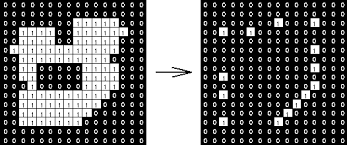Hit-or-miss transform is an operation that detects a given configuration in a binary image, using the morphological erosion operator and a pair of disjoint structuring elements. The result of the hit-or-miss transform is the set of positions where the first structuring element fits in the foreground of the input image, and the second structuring element misses it completely.
Hit-and-miss transform is a general binary morphological operation that can be used to look for particular patterns of foreground and background pixels in an image. Hit-or-miss transform is actually the basic operation of binary morphology since almost all the other binary morphological operators can be derived from it.
The structuring element used in the hit-and-miss is a slight extension to the type that has been introduced for erosion and dilation, in that it can contain both foreground and background pixels, rather than just foreground pixels, i.e. both ones and zeros. Note that the simpler type of structuring element used with erosion and dilation is often depicted containing both ones and zeros as well, but in that case the zeros really stand for `don’t care’s’, and are just used to fill out the structuring element to a convenient shaped kernel, usually a square.
In all our illustrations, these `don’t care’s’ are look like blanks in the kernel in order to avoid confusion. An example of the extend kind of structuring. As usual we denote foreground pixels using ones, and background pixels using zeros.
What is thinning and thickening in image processing?
In thinning the boundary of the object is subtract from the object. For a image A and a Composite structuring element B=(B1,B2),Thinning can be define as, AØB=A∩(A⊗B)C. Thickening: In Thickening a part of boundary of the background is add to the object.
What is erosion and dilation in image processing?
The most basic morphological operations are dilation and erosion. Dilation adds pixels to the boundaries of objects in an image, while erosion removes pixels on object boundaries. The rule used to process the pixels defines the operation as a dilation or an erosion.
What determine whether there is a hit or a miss?
A hit ratio is a calculation of cache hits, and comparing them with how many total content requests were receive. A miss ratio is the flip side of this where the cache misses are calculate and compare with the total number of content requests that were receive.
What is the use of Hough transform?
The Hough transform (HT) can be use to detect lines circles or • The Hough transform (HT) can be use to detect lines, circles or other parametric curves. It was introduce in 1962 (Hough 1962) and first used to find lines in images a decade later (Duda 1972). The goal is to find the location of lines in images.
Why thinning is use in image processing?
Thinning is a morphological operation that is use to remove selected foreground pixels from binary images, somewhat like erosion or opening. In this mode it is commonly use to tidy up the output of edge detectors by reducing all lines to single pixel thickness.
What is power law transformation in image processing?
A variety of devices for image capture, printing, and display respond according to a power law. The exponent in power law equation is refer to as gamma. Þ process use to correct this power law response phenomena is call as gamma correction. eg. – With =2.5, the CRT would produce images darker than intended.
What is blur of an image?
The blur, or smoothing, of an image removes “outlier” pixels that may be noise in the image. Blurring is an example of applying a low-pass filter to an image. In computer vision, the term “low-pass filter” applies to removing noise from an image. While leaving the majority of the image intact.
What is opening and closing in dip?
Opening is a process in which first erosion operation is perform and then dilation operation is perform. Closing is a process in which first dilation operation is perform and then erosion operation is perform.
What is cache hit?
A cache hit is a state in which data requested for processing by a component. Or application is match in the cache memory. It is a faster means of delivering data to the processor, as the cache already contains the requested data.





